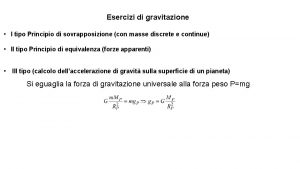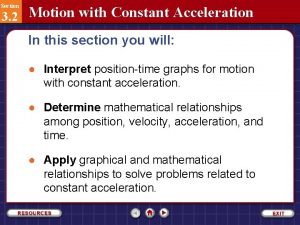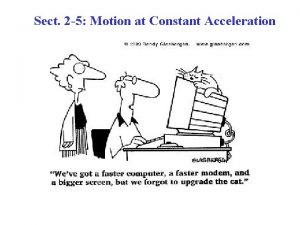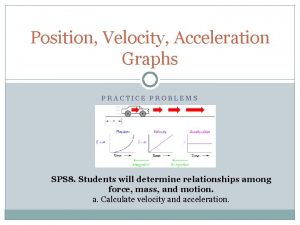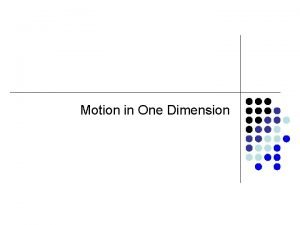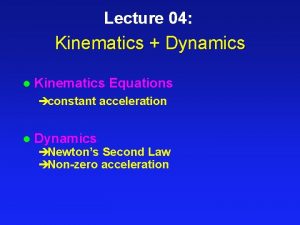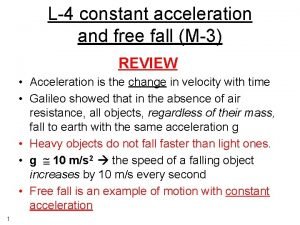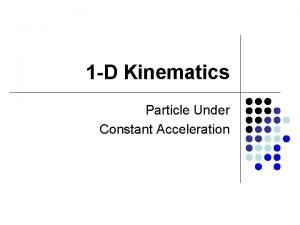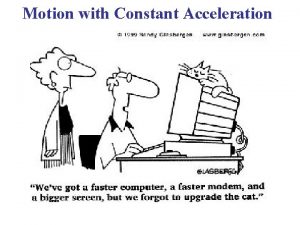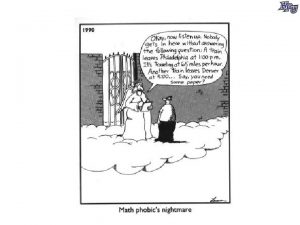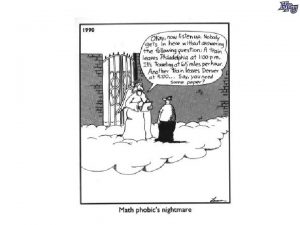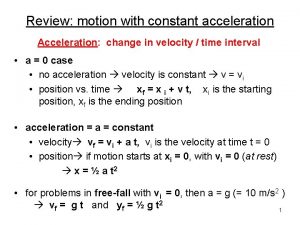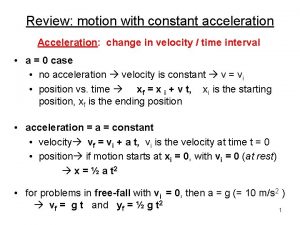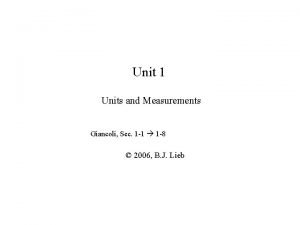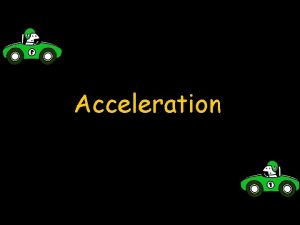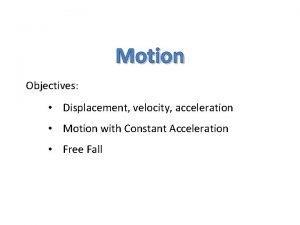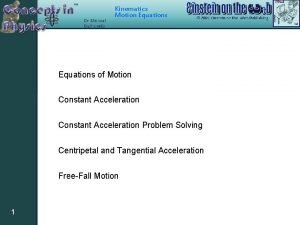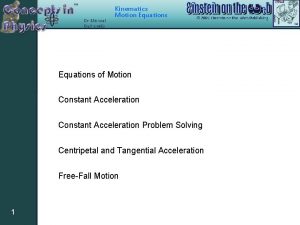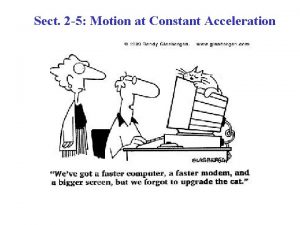Unit 3 Motion at Constant Acceleration Giancoli Sec
















- Slides: 16

Unit 3 Motion at Constant Acceleration Giancoli, Sec 2 - 5, 6, 8 © 2006, B. J. Lieb

Example 3 -1 Consider the case of a car that accelerates from rest with a constant acceleration of 15 m / s 2 starting at t 1 = 0. We see that velocity increases by 15 m/s every second and is thus a linear function of time. t (s) v ( m/s) a ( m/ s 2 ) 0 0 15 15 2 30 15 3 45 15 4 60 15 5 75 15 Unit 3 - 2

Derivation of Equations for Motion at Constant Acceleration • In the next 4 slides we will combine several known equations under the assumption that the acceleration is constant. • This process is called a derivation. • It will produce four equations connecting displacement, velocity, acceleration and time. • You will use these equations to solve most of the problems in Units 3, 4 and 7. Skip Derivation Unit 3 - 3

Derivations • Much research in Physics requires derivations. • In more advanced courses students are required to be able to perform derivations on tests and homework • In this course you will need to know the initial assumptions, the resultant equations and how to apply them. • You do not need to memorize derivations. • But I could ask you to derive an equation for a specific problem. This is very similar to an ordinary problem without a numeric answer. Unit 3 - 4

Motion at Constant Acceleration - Derivation • Consider the special case acceleration equals a constant: a = constant • Use the subscript “ 0” to refer to the initial conditions • Thus t 0 refers to the initial time and we will set t 0 = 0. • At this time v 0 is the initial velocity and x 0 is the initial displacement. • At a later time t, v is the velocity and x is the displacement • In the equations t 1 t 0 and t 2 t Unit 3 - 5

Motion at Constant Acceleration - Derivation The average velocity during this time is: The acceleration is assumed to be constant From this we can write Unit 3 - 6

Motion at Constant Acceleration - Derivation Because the velocity increases at a uniform rate, the average velocity is the average of the initial and final velocities From the definition of average velocity And thus Unit 3 - 7

Equations for Motion at Constant Acceleration • The book derives one more equation by eliminating time • The notation in the equations has changed • At t = 0, x 0 is the displacement and v 0 is the velocity • At a later time t, x is the displacement and v is the velocity Unit 3 - 8

Example 3 -2. A world-class sprinter can burst out of the blocks to essentially top speed (of about 11. 5 m/s) in the first 15. 0 m of the race. What is the average acceleration of this sprinter, and how long does it take him to reach that speed? (Note: we have to assume a=constant) Unit 3 -9

Graphical Analysis of Linear Motion • Consider the graph of x vs. t. The graph is a straight line, which means the slope is constant. • The slope of the line is the rise (Δy) over the run (Δx). • If we compare this with the definition of velocity, we see that the slope of the x vs. t graph is the velocity. Unit 2 - 10

Graphical Analysis of Linear Motion The graphs describe the motion of a car whose velocity is changing: v is the slope of position vs. time graph. Since the graph is not linear, we draw a tangent line at each point and find slope of the tangent line. Thus a is the slope of velocity vs. time graph. Unit 3 - 11

Example 3 -3: Calculate the acceleration between points A and B and C. Unit 3 - 12

Example 3 -4. A truck going at a constant speed of 25 m/s passes a car at rest. The instant the truck passes the car, the car begins to accelerate at a constant 1. 00 m / s 2. How long does it take for the car to catch up with the truck. When the car catches the truck: How far has the car traveled when it catches the truck? Unit 3 - 13

Example 3 -4: Graphical Interpretation In order to understand the solution to example 4, we can graph the two equations: • • • The graph of the truck (red) is linear because the velocity is constant. The car is accelerating so its graph (blue) is quadratic. The two curves intersect at t = 50 s which agrees with the solution. They intersect at x ~ 1250 m which also agrees. The slopes of the two graphs at t = 50 s indicate that the car is traveling twice as fast as the truck. Unit 3 - 14

Unit 3 Appendix Photo and Clip Art Credits Some figures electronically reproduced by permission of Pearson Education, Inc. , Upper Saddle River, New Jersey Giancoli, PHYSICS, 6/E © 2004. Slide 3 -2 Drawing: Copyright © Pearson Prentice Hall, Inc, reproduced with permission 3 -9 Sprinter: Microsoft Clipart Collection, reproduced under general license for educational purposes. 4 -10 Graphs: Copyright © Pearson Prentice Hall, Inc, reproduced with permission 4 -11 Graph: Copyright © Pearson Prentice Hall, Inc, reproduced with permission 4 -4 Photo: Copyright © Pearson Prentice Hall, Inc, reproduced with permission 4 -4 Graph: Copyright © Pearson Prentice Hall, Inc, reproduced with permission 4 -5, 6, 7 Soccer Kicker: Microsoft Clipart Collection, reproduced under general license for educational purposes. 4 -8, 9 Photo of Leaning Tower of Pisa: Microsoft Clipart Collection, reproduced under general license for educational purposes. Unit 03 - 15

Quadratic Equation A quadratic equation is a polynomial equation of the second degree (one term is squared). The general form of a quadratic equation is where a, b and c are constants and a is not equal to zero. You will need to arrange your equation in this form in order to determine the numeric value of a, b and c. Often this semester, the unknown variable will be t instead of x. A quadratic equation has two solutions or roots: and These solutions are usually combined using the ± symbol: • The solutions can be equal ( if b 2 = 4 a c ). • If they are not equal, you will often need to select the solution that makes sense for the problem. Unit 3 - 16
 Giancoli esercizi svolti
Giancoli esercizi svolti Motion section 3 acceleration
Motion section 3 acceleration Linear motion with constant acceleration
Linear motion with constant acceleration Is radial acceleration the same as centripetal acceleration
Is radial acceleration the same as centripetal acceleration Angular acceleration vs linear acceleration
Angular acceleration vs linear acceleration Is radial acceleration the same as centripetal acceleration
Is radial acceleration the same as centripetal acceleration Linear acceleration vs tangential acceleration
Linear acceleration vs tangential acceleration Tangential acceleration and centripetal acceleration
Tangential acceleration and centripetal acceleration M
M Position, velocity acceleration graphs practice
Position, velocity acceleration graphs practice Big four equations
Big four equations Kinematics equations
Kinematics equations Example of acceleration
Example of acceleration Speed time graph
Speed time graph Position error constant in control system
Position error constant in control system Which graphs in the gizmo show a negative relationship
Which graphs in the gizmo show a negative relationship Constant acceleration equations
Constant acceleration equations
